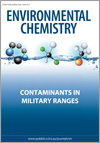Environmental context. Contaminants occur in the soil and water associated with military ranges. This review article describes how the extent of contamination depends not only on the type of military range and its period of activity, but also on the chemistry of both the soil and the contaminant. A full understanding of the soil chemistry is necessary to develop effective remediation methods for the restoration of these impacted environments.

Environmental Chemistry
Volume 16 Number 2 2019
Environmental context. Notwithstanding the environmental and geochemical significance of soil dissolved organic matter (DOM), its molecular components are still not well characterised. This study investigates chemical similarities and differences between two widely used forms of soil DOM: water-extractable organic matter and fulvic acids. The findings will guide appropriate extraction and purification protocols in future studies related to soil DOM.
EN18231Preliminary studies on the batch-dissolution kinetics of calcite with reactors open and closed to CO2
Environmental context. The dissolution of minerals in fresh or sea-waters is a critical environmental process. The rate at which substances dissolve, from the dissolution of calcite crystals to the weathering of mountains, can influence major global issues such as climate change and sea-level rise. This paper explores a new solution-based rate equation for mineral dissolution that has profound environmental consequences.
Environmental context. Volatile halocarbons play significant roles as halogen carriers in atmospheric chemistry where they contribute to global warming. We studied temporal and spatial variations of volatile halocarbons in the Northern Yellow Sea and Bohai Sea, and showed that their concentrations were governed by terrestrial input, hydrographic features and biological activity. The emission of volatile halocarbons from coastal regions could have important impacts on the budgets of atmospheric reactive halogen.
EN18181Photocatalysis of γ–cyclodextrin-functionalised Fe3O4 nanoparticles for degrading Bisphenol A in polluted waters
 , Vasile-Dan Hodoroabă, Rudolf J. Schneider, Gabriel Ababei and Ulrich Panne
, Vasile-Dan Hodoroabă, Rudolf J. Schneider, Gabriel Ababei and Ulrich Panne
Environmental context. Efficiently removing persistent organic pollutants, such as Bisphenol A, from wastewaters is essential for maintaining environmental quality. The present work applies advanced oxidation processes and the enhanced photocatalytic activity of cyclodextrin-immobilised magnetic nanoparticles for the removal of Bisphenol A under mild conditions. The study highlights the need to consider eco-friendly, safe and cost-effective approaches for the removal of persistent hazardous pollutants from wastewaters.
EN18235Molecular fractionation of dissolved organic matter on ferrihydrite: effects of dissolved cations
Environmental context. Carbon sequestration and dynamics are influenced by adsorptive fractionation of dissolved organic matter (DOM) on minerals. We found that the molecular fractionation of DOM on ferrihydrite was highly dependent on the presence of Na, Ca and Cu ions in water. These results advance our mechanistic understanding of the dynamic behaviour of DOM, and contribute to predicting carbon cycling and contaminant behaviour in the natural environment.



